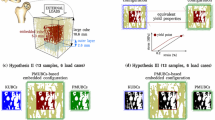Abstract
High-resolution finite element models of trabecular bone can be used to study trabecular structure–function relationships, elasticity, multiaxial strength, and tissue remodelling in more detail than experiments. Beside effects of the model size, scan/analysis resolution, segmentation process, etc., the type of the applied boundary conditions (BCs) have a strong influence on the predicted elastic properties. Appropriate BCs have to be applied on hexahedral digital finite element models in order to obtain effective elastic properties. Homogeneous displacement BCs as proposed by Van Rietbergen et al. (J Biomech 29(12):1653–1657, 1996) lead to “apparent” rather than to “effective” elastic properties. This study provides some answers concerning such differences by comparing various BC types (uniform displacement, mixed BCs, periodic BCs), different volume element definitions (original and mirrored models), and several bone volume fractions (BVTV ranging from 6.5 to 37.6%). First, the mixed BCs formulated by Hazanov (Arch Appl Mech 68(6):385–394, 1998) are theoretically extended to shear loading of a porous media. Second, six human bone samples are analyzed, their orthotropic Young’s moduli, shear moduli, and Poisson’s ratios computed and compared. It is found that the proposed mixed BCs give exactly the same effective elastic properties as periodic BCs if a periodic and orthotropic micro-structured material is used and thus denoted as “periodicity compatible” mixed uniform BCs (PMUBCs). As bone samples were shown to be nearly orthotropic for volume element side lengths ≥5 mm the proposed mixed BCs turn out to be the best choice because they give again essentially the same overall elastic properties as periodic BCs. For bone samples of smaller dimensions ( < 5 mm) with a strong anisotropy (beyond orthotropy) uniform displacement BCs remain applicable but they can significantly overestimate the effective stiffness.
Similar content being viewed by others
References
Anthoine A (1995). Derivation of the in-plane elastic characteristics of masonry through homogenization theory. Int J Solid Struct 32(2): 137–163
Bayraktar HH, Morgan EF, Niebur GL, Morris GE, Wong EK and Keaveny TM (2004). Comparison of the elastic and yield properties of human femoral trabecular and cortical bone tissue. J Biomech 37(1): 27–35
Dvorak GJ and Srinivas MV (1999). New estimates of overall properties of heterogeneous solids. J Mech Phys Solids 47(4): 899–920
Hazanov S (1998). Hill condition and overall properties of composites. Arch Appl Mech (Ingenieur Archiv) V 68(6): 385–394
Hazanov S (1999). On apparent properties of nonlinear heterogeneous bodies smaller than the representative volume. Acta Mech V 134(3): 123–134
Hazanov S and Amieur M (1995). On overall properties of elastic heterogeneous bodies smaller than the representative volume. Int J Eng Sci 33(9): 1289–1301
Hazanov S and Huet C (1994). Order relationships for boundary conditions effect in heterogeneous bodies smaller than the representative volume. J Mech Phys Solids 42(12): 1995–2011
Hill R (1963). Elastic properties of reinforced solids: some theoretical principles. J Mech Phys Solids 11: 127–140
Hollister SJ and Kikuchi N (1992). A comparison of homogenization and standard mechanics analyses for periodie porous composites. Comput Mech 10: 73–95
Hollister SJ and Kikuchi N (1994). Homogenization theory and digital imaging: a basis for studying the mechanics and design principles of bone tissue. Biotechnol Bioeng 43(7): 586–596
Huet C (1990). Application of variational concepts to size effects in elastic heterogeneous bodies. J Mech Phys Solids 38(6): 813–841
Kowalczyk P (2003). Elastic properties of cancellous bone derived from finite element models of parameterized microstructure cells. J Biomech 36(7): 961–972
Niebur GL, Feldstein MJ, Yuen JC, Chen TJ and Keaveny TM (2000). High-resolution finite element models with tissue strength asymmetry accurately predict failure of trabecular bone. J Biomech 33(12): 1575–1583
Ostoja-Starzewski M (2006). Material spatial randomness: from statistical to representative volume element. Probab Eng Mech 21(2): 112–132
Pahr DH (2003). Experimental and numerical investigations of perforated FRP-laminates, Fortschritt-Berichte VDI Reihe 18 Nr. 284. VDI-Verlag, Düsseldorf
Pahr DH and Rammerstorfer FG (2006). Buckling of honeycomb sandwiches: Periodic finite element considerations. CMES Comp Model Eng 12: 229–242
Suquet PM (1987). Lecture notes in physics—homogenization techniques for composite media. Chap IV. Springer, Heidelberg
Van Rietbergen B, Weinans H, Huiskes R and Odgaard A (1995). A new method to determine trabecular bone elastic properties and loading using micromechanical finite-element models. J Biomech 28(1): 69–81
Van Rietbergen B, Odgaard A, Kabel J and Huiskes R (1996). Direct mechanics assessment of elastic symmetries and properties of trabecular bone architecture. J Biomech 29(12): 1653–1657
Walpole LJ (1984). Fourth-rank tensors of the thirty-two crystal classes: Multiplication tables. Proc R Soc Lond Series A, Math Phys Sci 391: 149–179
Zysset PK (2003). A review of morphology-elasticity relationships in human trabecular bone: theories and experiments. J Biomech 36(10): 1469–1485
Zysset P-K, Goulet R-W and Hollister S-J (1998). A global relationship between trabecular bone morphology and homogenized elastic properties. J Biomech Eng 120(5): 640–6
Author information
Authors and Affiliations
Corresponding author
Additional information
In Memoriam, Prof. Christian Huet.
Rights and permissions
About this article
Cite this article
Pahr, D.H., Zysset, P.K. Influence of boundary conditions on computed apparent elastic properties of cancellous bone. Biomech Model Mechanobiol 7, 463–476 (2008). https://doi.org/10.1007/s10237-007-0109-7
Received:
Accepted:
Published:
Issue Date:
DOI: https://doi.org/10.1007/s10237-007-0109-7




